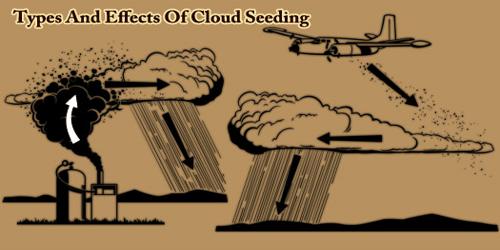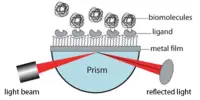Cloud Seeding, rainmaking, or man-made precipitation enhancement is a type of weather modification that aims to change the amount or type of precipitation that falls from clouds by dispersing substances into the air that serve as cloud condensation or ice nuclei, which alter the microphysical processes within the cloud. The usual intent is to increase precipitation (rain or snow), but hail and fog suppression are also widely practiced in airports where harsh weather conditions are experienced.
Cloud seeding also occurs due to ice nucleators in nature, most of which are bacterial in origin. With the added condensation nuclei, cloud seeding provides a base for snowflakes or raindrops to form.
It, therefore, follows that after cloud seeding, precipitation in the form of rain or snow will fall from the clouds back to earth. The intent or goal of cloud seeding is to increase the rain or snow precipitation, suppress hail, reduce lightning, or even dissipate the fog.
It is an efficient tool, especially in arid areas of the world, where rainfall is minimal under ordinary circumstances.
Cloud seeding has been practiced by a number of countries including India, the United Arab Emirates, the United States, China, and the United Kingdom. China has used the technology dependently in dry areas of the country. The UAE has used the technology since the 1990s, including in 2015 when they pumped about $5 million into their Research Program for Rain Enhancement Science. The US has employed the technology since the 1950s, especially in the Rocky Mountains, Sierra Nevada, and other mountainous and dry areas.
Despite the mixed scientific results, cloud seeding was attempted during the 2008 Summer Olympics in Beijing to coax rain showers out of clouds before they reached the Olympic city in order to prevent rain during the opening and closing ceremonies. Whether this attempt was successful is a matter of dispute, with Roelof Bruintjes, who leads the National Center for Atmospheric Research’s weather-modification group, remarking that “we cannot make clouds or chase clouds away.”
Types of Cloud Seeding –
The most common chemicals used for cloud seeding include silver iodide, potassium iodide, and dry ice (solid carbon dioxide). Liquid propane, which expands into a gas, has also been used. This can produce ice crystals at higher temperatures than silver iodide. After promising research, the use of hygroscopic materials, such as table salt, is becoming more popular.
When cloud seeding, increased snowfall takes place when temperatures within the clouds are between −4 and 19 °F (−20 and −7 °C). The introduction of a substance such as silver iodide, which has a crystalline structure similar to that of ice, will induce freezing nucleation.
There are three types of cloud seeding, they are:
Static Cloud seeding: This first of three methods work when a chemical compound is spread onto the clouds. It is the most commonly used method and involves the spraying of particles of salt, like silver iodide and chloride onto clouds.
Silver iodide (AgI) exists in the environment naturally and is not harmful to humans or wildlife. To do so, a special aircraft, rocket, or other dispersion device is used.
The salt particles act as a condensation nucleus, drawing water vapor within the cloud towards them.
Moisture will then latch onto them, condensing into water droplets. Subsequently, raindrops form, leading to rainfall.
Dynamic Cloud Seeding: This second type of seeding works by boosting the vertical air currents, encouraging more water to pass through the clouds. It, therefore, translates to more rain.
For it to work, about 100 times more ice crystals are required as compared to the static cloud seeding method. It is a more complex method as it relies on a sequence of events working properly.
Scientists within the atmospheric science departments as well as other researchers have broken the dynamic cloud seeding method into eleven separate stages. If one of the stages fails or its outcome is unexpected, the entire process is ruined. It also makes the technique less dependent as compared to the static cloud seeding method.
Hygroscopic Cloud Seeding: This last type utilizes the dispersal of salts through flares or explosives onto the lower parts of a cloud. The salt will become bigger and water will join it. It is a relatively new method that has been described as ‘promising.’ It, however, requires more research.
The goal of cloud seeding is to alter the natural development of the cloud to enhance precipitation, suppress hail, dissipate fog, or reduce lightning. Various cloud seeding techniques are employed, as particles are released from rockets, aircraft, or ground. The seeding of ice-phase clouds can induce the phase transition from a supercooled water cloud to one composed of ice. In the case of dynamic cloud seeding, the purpose is to stimulate vertical air motions through increased buoyancy caused by the release of latent heat of freezing.
Effects of Cloud Seeding –
With an NFPA 704 health hazard rating of 2, silver iodide can cause temporary incapacitation or possible residual injury to humans and other mammals with intense or chronic exposure. However, there have been several detailed ecological studies that showed negligible environmental and health impacts. The toxicity of silver and silver compounds (from silver iodide) was shown to be of low order in some studies. These findings likely result from the minute amounts of silver generated by cloud seeding, which are about one percent of industry emissions into the atmosphere in many parts of the world, or individual exposure from tooth fillings.
The process is not 100% effective – Despite the process being touted as highly successful in creating rain, it has raised concerns as to its actual effectiveness.
The main question that arises is, would rain have come in a certain place even without the need for the seeding? Cloud seeding becomes irrelevant if it would have rained regardless of it being used. It becomes difficult to ascertain if fluctuations in the level of rainfall, occurring during cloud seeding times, are produced by seeding or could have occurred naturally.
The process is very expensive – It is an innovative way of creating rainfall, especially in arid areas. However, it is an expensive process. In China, for instance, the country uses between $60 and $90 million every year on such weather modification projects.
Between 1995 and 2003, the country used $266 million for the same causes. As already mentioned, the UAE spent about $5 million in 2015 for its Research Program for Rain Enhancement Science.
Such monies could be used to fund other projects, given that it will inevitably rain. Also, if the aim is to bring rain to areas severely affected by climate change, wouldn’t it be easier to tackle global warming and climate change, as it would bring a long-lasting solution?
The truth about silver iodide is that it may potentially contain dangerous substances – Despite silver iodide being termed as safe for the environment, there remain concerns about exposure to the same, especially with regards to soil contamination.
Silver iodide has been known to result in incapacitation and possible residual injuries to humans and other animals, especially after chronic exposure. The toxicity of silver and its compounds in the environment might be low, but they are negative effects nonetheless.
Cloud seeding is not the end solution; it may actually worsen global warming and climate change – It has been argued that cloud seeding is just a way of sweeping the effects of pollution and climate change under the rug. Using cloud seeding to bring rainfall does not negate the fact that climate change exists and the process does nothing to fix the initial problem, which is global warming and climate change.
Since the process is expensive, it would be easier to fix the bigger problem and enjoy the long-term benefits of a better climate.
The results might be damaging more or less rain! – The end results of cloud seeding are either having no rain, like during the 2008 Beijing Olympics or having more rain, especially in dry areas. However, sometimes, the results have been damaging.
In 1974, a hurricane on the US East Coast was seeded using dry ice. The hurricane did not hit the area but moved to the west in Georgia. It caused severe damage, leading to General Electric Corporation being sued.
Operation Cumulus was as well an alleged to be series of secret scientific experiments being conducted in the UK between August 4th and 15th What followed were flash floods in Devon village in Lynmouth, England, killing 35 people.
Cloud seeding can be used for destructive purposes – According to Brown (2018), only 56 countries practiced cloud seeding activities in 2016. This means the possibility of more powerful countries using the process to attack other countries.
For instance, the US used cloud seeding to cause a monsoon in Ho Chi Minh, Vietnam, during the Vietnam War, as a tactic against the Vietnamese soldiers.
Cloud seeding has been the focus of many theories based on the belief that governments manipulate the weather in order to control various conditions, including global warming, populations, military weapons testing, public health, and flooding.
Information Sources:
















